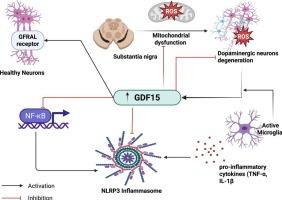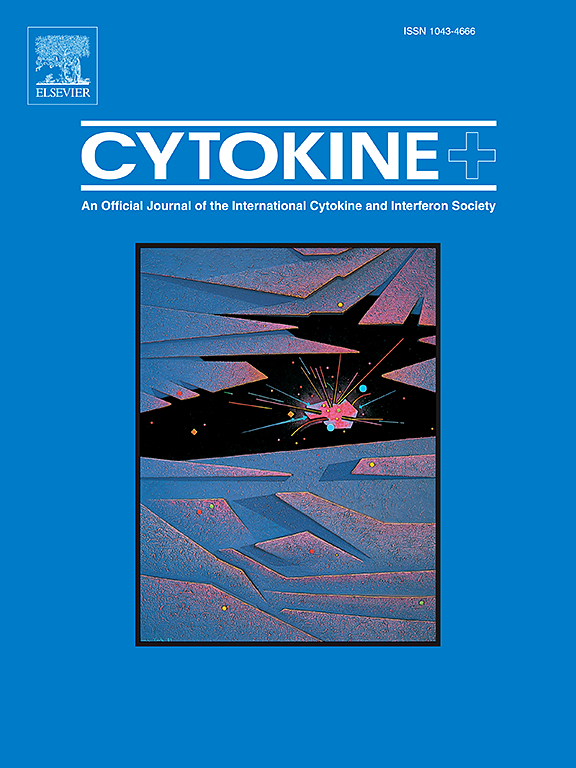GDF15 upregulation in Parkinson's disease: Compensatory mechanisms and causal insights
IF 3.7
3区 医学
Q2 BIOCHEMISTRY & MOLECULAR BIOLOGY
引用次数: 0
Abstract
Parkinson's disease (PD) is a prevalent long-term neurodegenerative condition resulting from the impairment of dopaminergic neurons (DNS) in the substantia nigra (SN). It is closely tied to inflammatory processes and oxidative stress, which worsen as PD neuropathology advances. Consequently, biomarkers linked to inflammation and oxidative stress may aid in diagnosing and monitoring PD progression. Growth differentiation factor 15 (GDF15) has emerged as a novel diagnostic biomarker for PD, though the exact reason for its elevation in PD remains unclear. This review seeks to investigate the cause-effect link between PD and heightened GDF15 levels. GDF15, part of the transforming growth factor-beta (TGF-β) family, exerts its effects through activation of the glial cell line-derived neurotrophic factor family receptor alpha-like (GFRAL). It serves a critical neuroprotective function in various brain disorders, including PD, where it enhances DNS survival, mitochondrial efficiency, and cellular energy metabolism. During PD progression, DNS degeneration may stimulate the release of anti-inflammatory GDF15 to counteract neuronal damage, though the precise mechanisms require further exploration. Elevated GDF15 levels in PD could reflect a response to cellular stress and mitochondrial dysfunction in DNS. GDF15 appears to suppress PD-related neuroinflammation by inhibiting the NLRP3 inflammasome, NF-κB signaling, and pro-inflammatory cytokine production. This suggests that increased GDF15 expression in PD may act as a compensatory mechanism to mitigate oxidative stress, mitochondrial impairment, and inflammatory pathways. As such, therapeutic strategies targeting GDF15 activation could hold promise for managing PD pathology. Further research is needed to clarify its regulatory pathways and therapeutic potential.

GDF15在帕金森病中的上调:代偿机制和因果关系
帕金森病(PD)是一种常见的长期神经退行性疾病,由黑质(SN)多巴胺能神经元(DNS)损伤引起。它与炎症过程和氧化应激密切相关,随着PD神经病理的进展,炎症过程和氧化应激会恶化。因此,与炎症和氧化应激相关的生物标志物可能有助于诊断和监测PD的进展。生长分化因子15 (GDF15)已成为PD的一种新的诊断生物标志物,尽管其在PD中升高的确切原因尚不清楚。本综述旨在探讨PD与GDF15水平升高之间的因果关系。GDF15是转化生长因子-β (TGF-β)家族的一员,通过激活胶质细胞系源性神经营养因子家族受体α样(GFRAL)发挥作用。它在包括帕金森病在内的各种脑部疾病中具有重要的神经保护功能,可提高DNS存活、线粒体效率和细胞能量代谢。在PD进展过程中,DNS变性可能刺激抗炎GDF15的释放以抵消神经元损伤,但其确切机制有待进一步探索。PD中GDF15水平升高可能反映了DNS对细胞应激和线粒体功能障碍的反应。GDF15似乎通过抑制NLRP3炎性体、NF-κB信号传导和促炎细胞因子的产生来抑制pd相关的神经炎症。这表明PD中GDF15表达的增加可能作为一种代偿机制来减轻氧化应激、线粒体损伤和炎症途径。因此,靶向GDF15激活的治疗策略有望控制PD病理。需要进一步的研究来阐明其调控途径和治疗潜力。
本文章由计算机程序翻译,如有差异,请以英文原文为准。
求助全文
约1分钟内获得全文
求助全文
来源期刊

Cytokine
医学-免疫学
CiteScore
7.60
自引率
2.60%
发文量
262
审稿时长
48 days
期刊介绍:
The journal Cytokine has an open access mirror journal Cytokine: X, sharing the same aims and scope, editorial team, submission system and rigorous peer review.
* Devoted exclusively to the study of the molecular biology, genetics, biochemistry, immunology, genome-wide association studies, pathobiology, diagnostic and clinical applications of all known interleukins, hematopoietic factors, growth factors, cytotoxins, interferons, new cytokines, and chemokines, Cytokine provides comprehensive coverage of cytokines and their mechanisms of actions, 12 times a year by publishing original high quality refereed scientific papers from prominent investigators in both the academic and industrial sectors.
We will publish 3 major types of manuscripts:
1) Original manuscripts describing research results.
2) Basic and clinical reviews describing cytokine actions and regulation.
3) Short commentaries/perspectives on recently published aspects of cytokines, pathogenesis and clinical results.
 求助内容:
求助内容: 应助结果提醒方式:
应助结果提醒方式:


